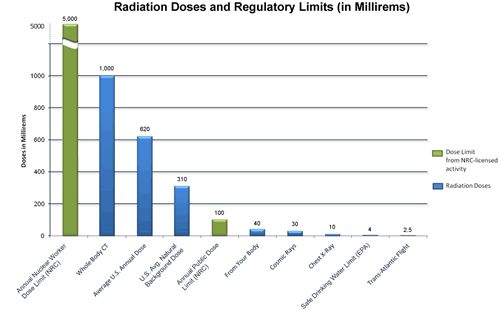Learn
Naturally-Occurring Radiation
Naturally-occurring radiation is radiation emission of energy in waves or particles that can be found all around us, specially in substances that are not man-made. Rocks, soil, the sun, and every food we eat bring us into contact with naturally occurring sources of radiation.
Watch the video Everyday Radiation (8:50) to learn about naturally-occurring radiation.
According to the U.S. Nuclear Regulatory Commission, there are three sources for naturally occurring radiation:

- Cosmic radiation – This is radiation from the sun and stars. It can vary with the elevation of the earth.
- Terrestrial radiation – This is radiation from the Earth itself. Rocks and soils as well as water and air naturally contain small amounts of radioactive materials that we are constantly exposed to.
- Internal radiation – Did you know that you are a source of radiation to others? That's right. Internal radiation comes from radioactive isotopes we all have in our bodies so just being around others exposes you to radiation – although not as much as the first two types!
Use the U.S. Nuclear Regulatory Commission website to investigate a little more about these types.
Man-made Radiation
You are probably most familiar with man-made radiation, such as radiation emitted by x-rays, televisions, and tobacco.

See a larger version of this radiation doses chart here. Chart courtesy of the U.S. Nuclear Regulatory Commission.
This chart from the U.S. Nuclear Regulatory Commission shows that the average annual dose of radiation in the United States (from all sources of radiation) 620 millirems. The average dose in the U.S. of naturally-occurring background radiation is 310 millirems. What a difference in our exposure to man-made radiation versus naturally-occurring radiation!
Examples of Everyday Radiation
Review the Facts about Nuclear Radiation below. Some of these examples of everyday radiation are naturally-occurring and some of these are man-made. We'll discuss more of the differences in the next tab.
Open Facts about Nuclear Radiation in new window | Facts about Nuclear Radiation text version
Naturally-Occurring Radiation vs. Man-Made Radiation
Review the chart below to understand the primary differences between natural radiation and man-made radiation.
| Natural Radiation | Man-made Radiation |
|---|---|
|
|
Use the following resources to explore more about the differences in natural and man-made radiation.
- Man-Made Sources (US NRC)
- Non-medical Sources of Man-made Radiation (American Cancer Society)
- Artificial Radioactivity (BBC Science)
Resources
You will be creating a public safety document in the Task, and these resources will prepare you to create this document.
- Naturally-Occurring Radioactive Materials (NORM) (World Nuclear Organization)
- Radiation is a part of our world (American Nuclear Society)
- Radiation in Everyday Life (International Atomic Energy Agency)
- Doses in Our Daily Lives (US NRC)
- Sources of Radiation Exposure in the United States (US NRC)
- Radiation Protection (US EPA)
- Radiation: Facts, Risks, and Realities (US EPA)

